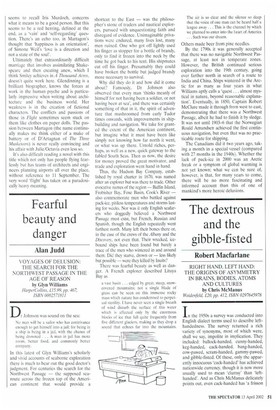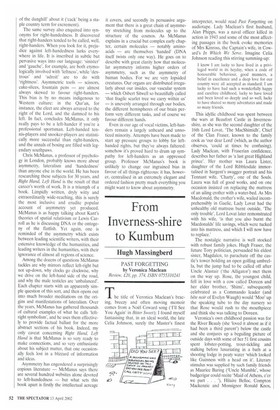The dextrous and the gibble-fisted
Robert Macfarlane
RIGHT HAND, LEFT HAND: THE ORIGINS OF ASYMMETRY IN BRAINS, BODIES, ATOMS AND CULTURES by Chris McManus
Weidenfeld, £20, pp. 412, ISBN 0297645978
In the 1950s a survey was conducted into English dialect terms used to describe lefthandedness. The survey returned a rich variety of synonyms, most of which were, shall we say, impolite in implication. They included: ballock-handed, cunny-handed, keg-handed, cack-handed, bang-handed, cow-pawed, scram-handed, gammy-pawed, and gibble-fisted. Of these, only the apparently innocuous `cack-handed' has achieved nationwide currency, though it is now more usually used to mean 'clumsy' than `lefthanded'. And as Chris McManus delicately points out, even cack-handed has `a frisson
of the dunghill' about it ('cack' being a staple country term for excrement).
The same survey also enquired into synonyms for right-handedness. It discovered that right-handers tended to be called, well, right-handers. When you look for it, prejudice against left-handedness lurks everywhere in life. It is inscribed in subtle but pervasive ways into our language: 'sinister' and 'gauche', for example, are both etymologically involved with leftness', while 'dextrous' and 'adroit' are to do with 'rightness'. Asymmetric tools — scissors, cake-slices, fountain pens — are almost always skewed to favour right-handers. This bias is by no means indigenous to Western culture: in the Qur'an, for instance, the elect are always arrayed to the right of the Lord, and the damned to his left. In fact, concludes McManus, it only really pays to be a left-hander if you're a professional sportsman. Left-handed tennis-players and snooker-players are statistically more successful than right-handers, and the annals of boxing are filled with legendary southpaws.
Chris McManus, a professor of psychology in London, probably knows more about asymmetry, lateralism and 'handedness' than anyone else in the world. He has been researching these subjects for 30 years, and Right Hand Left Hand is the result of that career's worth of work. It is a triumph of a book. Limpidly written, dryly witty and extraordinarily wide-reaching, this is surely the most inclusive and erudite popular account of asymmetry yet produced. McManus is as happy talking about Kant's theories of spatial relativism or Lewis Carroll as he is discussing DNA or the ontogeny of the flatfish. Yet again, one is reminded of the asymmetry which exists between leading scientific writers, with their extensive knowledge of the humanities, and leading writers in the humanities, with their ignorance of almost all regions of science.
Among the dozens of questions McManus tackles are why mirrors reflect left-right but not up-down, why clocks go clockwise, why we drive on the left-hand side of the road, and why the male testicles are 'unbalanced'. Each chapter starts with an apparently simple question of this sort, and then opens out into much broader meditations on the origins and manifestations of lateralism. Over the years, McManus has gathered thousands of cultural examples of what he calls 'leftright symbolism', and he uses them effectively to provide factual ballast for the more abstract sections of his book. Indeed, my only caveat concerning Right Hand Left Hand is that McManus is so very ready to make connections, and so very enthusiastic about his subject matter, that one occasionally feels lost in a blizzard of information and ideas.
Asymmetry has engendered a surprisingly copious literature — McManus says there are several hundred websites alone devoted to left-handedness — but what sets this book apart is firstly the intellectual acreage it covers, and secondly its persuasive argument that there is a great chain of asymmetry stretching from molecules up to the structure of the cosmos. As McManus explains in a crucial but complex early chapter, certain molecules — notably aminoacids — are themselves 'handed' (DNA itself twists only one way). He goes on to describe with great clarity how that molecular asymmetry informs higher orders of asymmetry, such as the asymmetry of human bodies. For we are very lopsided creatures. Our organs are distributed irregularly about our insides, our vascular system — which Osbert Sitwell so beautifully called 'that fragile scarlet tree we carry within us' — is unevenly arranged through our bodies, the different hemispheres of our brain perform very different tasks, and of course we favour different hands.
Even in our age of vocal victims, left-handers remain a largely unheard and unnoticed minority. Attempts have been made to start up pressure groups to lobby for lefthanded rights, but they've always faltered: somehow it's proved hard to drum up sympathy for left-handers as an oppressed group. Professor McManus's book is unlikely to change our ingrained bias in favour of all things righteous: it has, however, centralised in an extremely elegant and ordered fashion pretty much everything you might want to know about asymmetry.



















































































 Previous page
Previous page